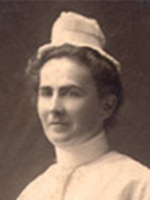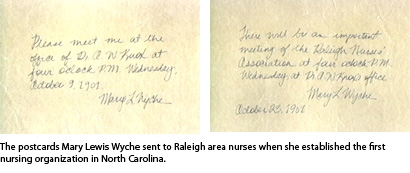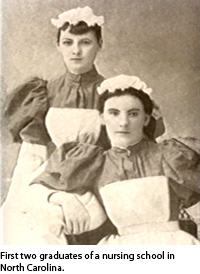NCNA Biography of Mary Lewis Wyche
 Mary Lewis Wyche was born on February 26, 1858 near Henderson in Vance County. As a young woman, she wanted to become a nurse but was thwarted by both family obligations and the absence of any schools of nursing in North Carolina. Her calling to become a nurse was so great that when she was able, she moved to Philadelphia to study nursing and graduated from Philadelphia General Hospital Training School in 1894. Upon graduation, she returned to the Tarheel State and revolutionized the nursing profession (Rogers, 1949). Wyche should be fondly remembered by NC nurses for four primary achievements: the establishment of the first school of nursing in NC, the creation of the first professional nursing organization in the state, the passage of the first nurse registration law in the country and for writing the only book about the history of nursing in North Carolina.
Mary Lewis Wyche was born on February 26, 1858 near Henderson in Vance County. As a young woman, she wanted to become a nurse but was thwarted by both family obligations and the absence of any schools of nursing in North Carolina. Her calling to become a nurse was so great that when she was able, she moved to Philadelphia to study nursing and graduated from Philadelphia General Hospital Training School in 1894. Upon graduation, she returned to the Tarheel State and revolutionized the nursing profession (Rogers, 1949). Wyche should be fondly remembered by NC nurses for four primary achievements: the establishment of the first school of nursing in NC, the creation of the first professional nursing organization in the state, the passage of the first nurse registration law in the country and for writing the only book about the history of nursing in North Carolina.
Wyche’s first major accomplishment was the establishment of the first school of nursing in North Carolina. After graduating from nursing school, Wyche’s became the matron (Chief Nursing Officer) of the newly established Rex Hospital in Raleigh. Understanding the importance of an educated nursing workforce to the health of the states’ citizens, Wyche undertook the major task of creating the first school of nursing in North Carolina - Rex Hospital Training School for Nurses. Wyche recalled the early days of the school this way: “The hospital of only 23 beds was rather small to have a school of nursing, but there were patients who needed care and young women who wanted to be taught the art of nursing” (Wyche, 1938).
 Five students were in the first class. They reported to the hospital at 8 in the morning and remained until 6 pm every night. Classes were held four times a week and included anatomy, surgery, material medica, obstetrics and practical nursing. The classroom was located close enough to the patient care area that students could hear the call bells and leave class to take care of patients when needed. After 2 and ½ years of training, the first class graduated in 1897, becoming the first North Carolina trained graduate nurses (Wyche, 1938).
Five students were in the first class. They reported to the hospital at 8 in the morning and remained until 6 pm every night. Classes were held four times a week and included anatomy, surgery, material medica, obstetrics and practical nursing. The classroom was located close enough to the patient care area that students could hear the call bells and leave class to take care of patients when needed. After 2 and ½ years of training, the first class graduated in 1897, becoming the first North Carolina trained graduate nurses (Wyche, 1938).
Wyche’s was responsible for the creation of the North Carolina State Nurses Association. Wyche frequently attended professional gatherings in other states. After meeting with other nurses at the International Council of Nurses in Buffalo, New York in the spring of 1901, she returned to Raleigh determined to form a state wide nursing organization dedicated to using nursing registration and legislative advocacy to improve the profession and patient care. However, her new task was not easily accomplished. Wyche sent postcards to every nurse in Raleigh requesting their presence at a founding meeting of the Raleigh Nurses Association. Unfortunately not a single nurse showed up. However, Wyche was not a quitter. In two weeks she sent a second postcard inviting the same nurses to an important meeting of the newly formed Raleigh Nurses Association. This piqued the nurses’ curiosity, and every single graduate nurse in Raleigh attended the meeting. Soon the Raleigh Nurses Association started work on forming the North Carolina State Nurses Association (Centennial committee, 2003). In 1902, the Raleigh group invited every nurse they were aware of in North Carolina to a meeting in Raleigh during the week of the State Fair. The railroads offered discount fares to Raleigh during Fair Week and the Fair itself would be a draw. Fourteen nurses from across the state met with the members of the Raleigh Nurses Association on October 28, 1902 and launched the North Carolina State Nurses Association (Centennial Committee, 2003).
 At the time of the founding of the NCSNA, it was extremely rare in North Carolina for people of different races to meet together for a common purpose. Public establishments such as convention halls and restaurants were legally segregated by race. A group of African American nurses, led by Carrie Early Broadfoot organized the NC Association of Colored Graduate Nurses in 1920 and ran this parallel professional organization until the two associations united to represent all nurses in North Carolina in 1949 (Pollitt & Reese, 1997) .
At the time of the founding of the NCSNA, it was extremely rare in North Carolina for people of different races to meet together for a common purpose. Public establishments such as convention halls and restaurants were legally segregated by race. A group of African American nurses, led by Carrie Early Broadfoot organized the NC Association of Colored Graduate Nurses in 1920 and ran this parallel professional organization until the two associations united to represent all nurses in North Carolina in 1949 (Pollitt & Reese, 1997) .
Wyche’s work was not complete after founding the first nursing school and the first professional nursing organization in
North Carolina. Her third major success occurred on March 3rd, 1903 when the NCNA, pushed a bill through the state legislature that was signed by Governor Charles Aycock, making North Carolina the first state in the nation mandating registration for nurses (Wyche, 1938). For the first time, nurses had some control over the quality and education of people practicing nursing. Registration provides safeguards for the public and the profession. Josephine Burton of Craven County became the first registered nurse in North Carolina, and therefore the first registered nurse in the United States on June 4, 1903 (Wyche, 1938)
Wyche’s final major endeavor for nurses in North Carolina was compiling and writing the only book on the history of nursing in North Carolina. By preserving and recording the accomplishments of early nurses and the profession in its infancy, Wyche has given all of us a gift of inspiration and motivation to continue the work she started.
Article republished with permission from North Carolina Nurses Association
Dunnwyche
In the decades around the turn of the twentieth century, most nurses worked as private duty nurses and lived in the homes of their patients. As their patient recovered or died the nurse would find temporary housing until she was hired for her next case. Few private duty nurses maintained their own homes. Nurses in some cities, including Asheville, established “Nurse’s Clubs”, where nurses could rent rooms between cases. In the days before immunizations, antibiotics and other effective treatments for disease, patients often took to bed for weeks and months at a time. Unfortunately, nurses often contracted the diseases of their patient. Because tuberculosis was one of the leading causes of death at this time, many nurses became afflicted with this disease. Most nurses were single women and had limited means. Without a permanent home and unable to stay in Nurses Clubs, local YWCAs or other temporary housing, tubercular nurses were often in desperate straights.
At the 1911 annual meeting of the North Carolina State Nurses Association (NCSNA), the professional organization for white nurses in the state, Nurse Birdie Dunn proposed the construction of a home for sick and disabled nurses to be supported by the NCSNA. It was to be a place where nurses who became ill while treating others could find care and respite. The attendees enthusiastically agreed to support this effort. A site was found near the town of Black Mountain in eastern Buncombe County near two other operating sanatoria. Nurses across the state held bake sales, tag sales and sold dolls created in the likeness of student nurses to raise money to support their new institution, Dunnwyche (named in honor of nurses Birdie Dunn and Mary Wyche).
Dunnwyche accepted its first patients in 1913. The Home offered fresh spring water, electricity, a furnace and sleeping porches. Dr, Archer, who owned and managed the nearby Craigmont Sanitarium, volunteered his services to the nurses. Each of the seven districts comprising the state organization furnished and equipped one room. Nurses across the state sent homemade crafts to brighten the rooms. While the prescribed treatment for TB was rest and breathing fresh, clean air, patients wrote about automobile trips, playing the piano, listening to the Victrola, card parties and visits from friends and family to help break up the monotony of “taking the cure”.
Dunnwyche was a success until 1919. During the years of World War One (WWI) the costs of food and fuel escalated, and it became increasingly difficult to find suitable employees. The U.S. Army built a 1,500 bed sanatorium at nearby Oteen to care for soldiers with tuberculosis and those whose lungs had been harmed by poison gasses used as weapons in WWI. The Army pay scale for nurses and attendants was higher than the NCSNA could afford to meet. The Dunnwyche Board of Directors voted to sell the building and invest the proceeds in Liberty Bonds. Interest from the Bonds was then used to establish NCSNA Relief Fund. Nurses who acquired disease or disability while providing care could apply for monies to offset treatment costs through the Relief Fund.
References
- Pollitt, P.A. (2009, Winter) "Mary Lewis Wyche" Tar Heel Nurse, p.18.
- Centennial Committee (2003) North Carolina Nurses: A century of caring . USA: NC Board of Nursing.
- Pollitt, P. & Reese, C. (1997). "The North Carolina Association of Colored Graduate Nurses: a proud heritage."ABNF Journal. 8(2), 32-4
- Rogers, L. (1949). Tar Heel Women. Warren Publishing Co. Raleigh, NC.
- Wyche, M.L. (1938). The history of nursing in North Carolina. University of North Carolina Press: Chapel Hill, NC.
- Wyche, M.L. (1919 ) A pre-nursing course outlined. American Journal of Nursing. 19(9). p. 715.
- North Carolina Highway Historical Marker dedicated to Wyche
- City of Williamsboro Historical Markers - Mary L. Wyche, 1858-1936
- Joint Resolution Honoring the Life and Memory of Mary Lewis Wyche passed by the NC State Legislature
Biographies
Miscellaneous
- Joint Resolution Honoring the Life and Memory of Mary Lewis Wyche passed by the NC State Legislation
- City of Williamsboro Historical Marker (alternate link)